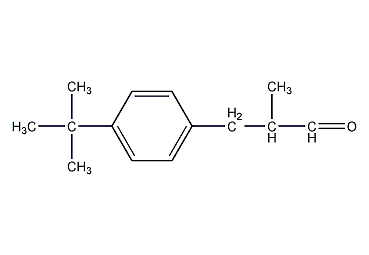
Structural formula
| Business number | 01R7 |
|---|---|
| Molecular formula | C14H20O |
| Molecular weight | 204.31 |
| label |
Lyris aldehyde; α-methyl p-tert-butylphenylpropionaldehyde, Lyral, α-methyl tert-butyl-styrene-formaldehyde, artificial flavors |
Numbering system
CAS number:80-54-6
MDL number:MFCD00047655
EINECS number:201-289-8
RTECS number:MW4895000
BRN number:None
PubChem number:24890134
Physical property data
1. Properties: Colorless and transparent liquid 2. Density (g/mL, 20/4℃): 0.942-0.947
3. Relative vapor density (g/mL, air=1): Uncertain
4. Melting point (ºC): Uncertain
5. Boiling point (ºC, 0.80kPa): 126-127
6. Boiling point (ºC, 0.133kPa): 96- 98
7. Refractive index: 1.504-1.507
8. Flash point (ºC): Uncertain
9. Specific rotation (º): Uncertain Determined
10. Autoignition point or ignition temperature (ºC): Uncertain
11. Vapor pressure (kPa, 25ºC): Uncertain
12. Saturated vapor pressure (kPa, 60ºC): Uncertain
13. Heat of combustion (KJ/mol): Uncertain
14. Critical temperature (ºC): Uncertain
15. Critical pressure (KPa): Uncertain
16. Log value of oil-water (octanol/water) partition coefficient: Uncertain
17. Explosion upper limit ( %, V/V): Uncertain
18. Lower explosion limit (%, V/V): Uncertain
19. Solubility: soluble in ethanol, oil, insoluble in water
Toxicological data
1. Acute toxicity Rat caliber LD50: 123700mg/kg;
2. Neurotoxicity Rabbit skin test: 500mg/24H;
Ecological data
None yet
Molecular structure data
1. Molar refractive index: 63.60
2. Molar volume (cm3/mol): 219.6
3. Isotonic specific volume (90.2K ): 517.7
4. Surface tension (dyne/cm): 30.8
5. Polarizability (10-24cm3):25.21
Compute chemical data
1. Reference value for hydrophobic parameter calculation (XlogP): 3.9
2. Number of hydrogen bond donors: 0
3. Number of hydrogen bond acceptors: 1
4. Number of rotatable chemical bonds: 4
5. Number of tautomers: 2
6. Topological molecular polaritySurface area 17.1
7. Number of heavy atoms: 15
8. Surface charge: 0
9. Complexity: 194
10 .The number of isotope atoms: 0
11. The number of determined atomic stereocenters: 0
12. The number of uncertain atomic stereocenters: 1
13. Determined number of stereocenters of chemical bonds: 0
14. Number of uncertain stereocenters of chemical bonds: 0
15. Number of covalent bond units: 1
Properties and stability
It has the floral fragrance of lily of the valley, lily and rabbit ear.
Storage method
This product should be sealed and stored away from light.
Synthesis method
P-tert-butylbenzyl chloride is obtained by reacting tert-butylbenzene with formaldehyde and hydrochloric acid, which is then reacted with tropine to form p-tert-butylbenzaldehyde, which is further condensed with propionaldehyde to obtain pro-lilyaldehyde, and finally is selected Lily aldehyde is produced by hydrogenation.
Purpose
This product has a sweet lily fragrance, is less irritating to the skin, and is stable to alkali. It is widely used in lily, clove, magnolia, camellia, orchid, and oriental fragrance daily flavors. It is commonly used as a fragrance in soaps and detergents, and can also be used as a fragrance in floral cosmetics.


